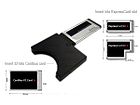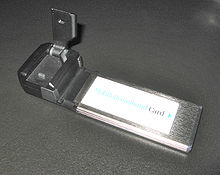- ExpressCard
-
ExpressCard 
Year created 2003 Supersedes PC Card Number of devices 1 per slot Capacity 480 Mbit/s (USB mode) and
2.5 Gbit/s (PCI Express mode)Style Serial Hotplugging interface Yes External interface Yes ExpressCard is an interface to allow peripheral devices to be connected to a computer, usually a laptop computer. Formerly called NEWCARD,[1] the ExpressCard standard specifies the design of slots built into the computer and of cards which can be inserted into ExpressCard slots. The cards contain electronic circuitry and connectors to which external devices can be connected. The ExpressCard standard replaces the PC Card (also known as PCMCIA) standards.
Hardware that may be plugged into a computer via an ExpressCard includes connect cards, FireWire 800 (1394B), USB 2.0, USB 3.0 , Ethernet (even Gigabit Ethernet), Serial ATA external stick drives, solid-state drives, external enclosures for desktop size PCI Express graphics cards, wireless network interface cards (NIC), TV tuner cards, Common Access Card (CAC) readers, and soundcards and many others devices using chips which connects to computer using with USB or PCIe.
Contents
Standards
Originally developed by the Personal Computer Memory Card International Association (PCMCIA), the ExpressCard standard is maintained by the USB Implementers Forum (USB-IF). The host device supports PCI Express, USB 2.0, and SuperSpeed USB[2] (ExpressCard 2.0 only) connectivity through the ExpressCard slot; cards can be designed to use any of these modes. The cards are hot-pluggable. The ExpressCard standard is an open standard by ITU-T definition, and can be obtained from the USB-IF website free of charge[3].
USB-IF administers the ExpressCard Compliance Program, under which companies earn the right to obtain a license to use the ExpressCard logo on their compliant products[4].
Form factors
The ExpressCard standard specifies two form factors, ExpressCard/34 (34 mm wide) and ExpressCard/54 (54 mm wide, in an L-shape)—the connector is the same on both (34 mm wide). Standard cards are 75 mm long (10.6 mm shorter than CardBus) and 5 mm thick, but may be thicker on sections that extend outside the standard form for Antennas, sockets, etc.
The 34 mm slot accepts only 34 mm cards. The 54 mm slot accepts both 34 mm and 54 mm cards. A diagonal guide in the rear of the 54 mm slot guides 34 mm cards to the connector. Adapters are available for connecting an ExpressCard/34 card to a CardBus (but not 16-bit PC Card) slot.
Comparison to other standards
The older PC Cards came in 16-bit and the later 32-bit CardBus designs. The major benefit of the ExpressCard over the PC card is more bandwidth, due to the ExpressCard's direct connection to the system bus over a PCI Express ×1 lane and USB 2.0, while CardBus cards only interface with PCI. The ExpressCard has a maximum throughput of 2.5 Gbit/s through PCI Express and 480 Mbit/s through USB 2.0 dedicated for each slot, while all CardBus devices connected to a computer share a total 1.06 Gbit/s bandwidth.
The ExpressCard standard specifies voltages of either 1.5 V or 3.3 V; CardBus slots can use 3.3 V or 5.0 V. The ExpressCard FAQ claims lower cost, better scalability, and better integration with motherboard chipset technology than Cardbus. PCMCIA devices can be connected to an ExpressCard slot via an adapter.
When the PC Card was introduced, the only other way to connect peripherals to a laptop computer was via obsolescent RS232 and parallel ports of limited performance, so it was widely adopted for many peripherals. More recently, virtually all laptop equipment has 480 Mbit/s Hi-Speed USB 2.0 ports, and most types of peripheral which formerly used a PC Card connection are available for USB, making the ExpressCard less necessary than the PC Card was in its day. Some laptop computers do not have an ExpressCard slot.
Availability
An ExpressCard slot had been commonly included on high-end laptops made since 2006:
- Hewlett-Packard began shipping systems with ExpressCard in November 2004.[5]
- Lenovo integrated the slot into their flagship ThinkPad T43 in May 2005.[6]
- Dell Computer also incorporates this in their Precision (the 17 in models have them exclusively, the 15 in Precisions have both express card and PCMCIA Card slots), Inspiron, Latitude (Latitude D-series have PCMCIA card slots. The D820/D830 have both ExpressCard and PCMCIA card slots), Studio, Vostro and XPS Laptop product lines.
- Fujitsu-Siemens began shipping systems[7] with ExpressCard in mid 2005.
- Apple Inc. included single ExpressCard/34 slots in every MacBook Pro notebook computer from January 2006 through June 2009. At the June 8, 2009 Apple Worldwide Developers Conference the company announced that the 15-inch and 13-inch MacBook Pro models would replace the ExpressCard slot with a Secure Digital card slot, while retaining the ExpressCard slot on the 17-inch model.
- ASUS has also replaced the PC Card slot with an ExpressCard slot on many of its new models.
- Sony also began shipping systems[8] with ExpressCard with its new laptop VGN-SZ, VGN-NS, VPC and FW product line.
- The Acer Aspire laptop series also has a single ExpressCard/54 slot on most new models.
- Panasonic incorporates ExpressCard/54 slots in all the fully rugged and semi-rugged models of their Toughbook brand of laptop computers.
- Gateway notebooks (ML3109 and later) also ship with ExpressCard/54 interfaces.
Because of the lack of backward compatibility, some laptop manufacturers have chosen to release models incorporating both CardBus (PCMCIA, PC Card) and ExpressCard slots. These include certain models of Acer Aspire, Acer Extensa, Toshiba Satellite, Dell Latitude and Precision, MSI S42x and Lenovo ThinkPad Z60m, R52, T60 and R61.
A large number of ExpressCard devices were presented at the CeBit trade show in Germany in March 2005.[9] In November 2006, Belkin announced that it is launching the first ExpressCard docking station, which uses the PCIe part of an ExpressCard connection to enable 1600x1200 video and the USB part to provide USB, audio and network ports.[10][11] This points to the ability for ExpressCard to allow more capable non-OEM docking stations for laptop computers.
In 2007, Sony introduced its Vaio TZ model, which incorporates ExpressCards. Also the Sony Vaio FZ and Vaio Z series have the ExpressCard/34 Slot integrated in them. Sony also uses the ExpressCard/34 form factor for the flash memory modules in its XDCAM EX/SxS based camcorders, making the copying of video data between these cameras and ExpressCard-equipped laptops easier. For this reason, Sony also offers a USB-based SxS reader for desktop computers.
The new Toshiba Satellite P and X 200/205 series of laptops and desktop replacements have an ExpressCard/34 slot since April 2007.
ExpressCard 2.0
The ExpressCard 2.0 standard was delivered March 4, 2009 at CeBIT in Hannover. It is expected to have a raw bandwidth of 5 Gbit/s (transfer speed 500 MB/s or 0.5 GB/s),[12] which is ten times USB 2.0 (0.48 Gbit/s or 60 MB/s),[13] and includes USB 3.0 (5.0 Gbit/s or 625 MB/s or 0.625 GB/s).[14] It complies with PCI-Express 2.0 and SuperSpeed USB, which is part of the USB 3.0 specification. It is backwards compatible with current ExpressCard modules and ExpressCard 2.0 modules will work in current slots. ExpressCard 2.0 products are expected to be in the market in late 2010.[15]
See also
References
- ^ "NEWCARD Reborn As 'ExpressCard'". http://www.wi-fiplanet.com/news/article.php/3077821. Retrieved 2009-02-25.
- ^ http://www.usb.org/developers/expresscard
- ^ http://www.usb.org/developers/expresscard/EC_specifications
- ^ http://www.usb.org/developers/expresscard/expresscard_compliance
- ^ http://www.pcmag.com/article2/0,1759,1706542,00.asp
- ^ http://www-131.ibm.com/webapp/wcs/stores/servlet/CategoryDisplay?catalogId=-840&storeId=10000001&langId=-1&dualCurrId=1000073&categoryId=2072541
- ^ http://www.fujitsu-siemens.com/home/products/notebooks/amilo_m_3438_4438.html
- ^ http://www.sonystyle.com/is-bin/INTERSHOP.enfinity/eCS/Store/en/-/USD/SY_BrowseCatalog-Start?CategoryName=cpu_VAIONotebookComputers_SZSeries&Dept=computers
- ^ http://www.itnews.com.au/newsstory.aspx?CIaNCID=46&CIaNID=18253
- ^ http://www.belkin.com/pressroom/releases/uploads/10_10_06NotebookExpansionDock.html
- ^ http://www.belkin.com/highspeeddock/
- ^ "PCI Express 3.0 Frequently Asked Questions". PCI-SIG. http://www.pcisig.com/news_room/faqs/pcie3.0_faq/. Retrieved 18 February 2010.
- ^ Universal Serial Bus 3.0 Specification, 4.4.11 "Efficiency"
- ^ ExpressCard 2.0 FAQ (pdf) at ExpressCard.org, accessed 2009-12-04.
- ^ ExpressCard 2.0
External links
- ExpressCard Technology from PCMCIA
- allpinouts.org - PCI Express Card and PCI Express Mini Card Connector Pinout
Computer bus official and de facto standards (wired) General - System bus
- Front-side bus
- Back-side bus
- Daisy chain
- Control bus
- Address bus
- Bus contention
- Plug and play
- List of bus bandwidths
Standards - S-100 bus
- Unibus
- VAXBI
- MBus
- STD Bus
- SMBus
- Q-Bus
- ISA
- Zorro II
- Zorro III
- CAMAC
- FASTBUS
- LPC
- HP Precision Bus
- EISA
- VME
- VXI
- NuBus
- TURBOchannel
- MCA
- SBus
- VLB
- PCI
- PXI
- HP GSC bus
- CoreConnect
- InfiniBand
- UPA
- PCI-X
- AGP
- PCI Express
- Intel QuickPath Interconnect
- HyperTransport
Portable - PC Card
- ExpressCard
Embedded - Multidrop bus
- AMBA
- Wishbone
Storage - ST-506
- ESDI
- SMD
- Parallel ATA (PATA)
- DMA
- SSA
- HIPPI
- USB MSC
- FireWire (1394)
- Serial ATA (SATA)
- eSATA
- eSATAp
- SCSI
- Parallel SCSI
- Serial Attached SCSI (SAS)
- Fibre Channel (FC)
- iSCSI
- ATAoE
Peripheral - Apple Desktop Bus
- HIL
- MIDI
- Multibus
- RS-232 (serial port)
- DMX512-A
- IEEE-488 (GPIB)
- EIA/RS-422
- IEEE-1284 (parallel port)
- UNI/O
- ACCESS.bus
- 1-Wire
- I²C
- SPI
- EIA/RS-485
- Parallel SCSI
- Profibus
- USB
- FireWire (1394)
- Fibre Channel
- Camera Link
- External PCI Express x16
- Thunderbolt
Memory cards Main articles 
Types CompactFlash (CF) • Express Card • JEIDA • MultiMediaCard (MMC) • Memory Stick (MS/MS-PRO) • miCard • Microdrive (MD) • MiniCard • P2 • PC Card (PCMCIA, CardBus, CardBay) • Secure Digital (SD) • SmartMedia (SM) • SxS • Universal Flash Storage (UFS) • USB • xD-PictureCategories:- Standards organizations
- Motherboard
- ExpressCards
Wikimedia Foundation. 2010.



